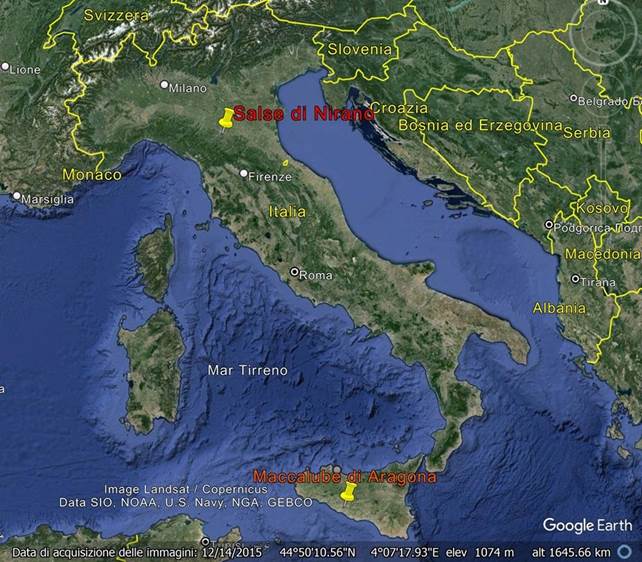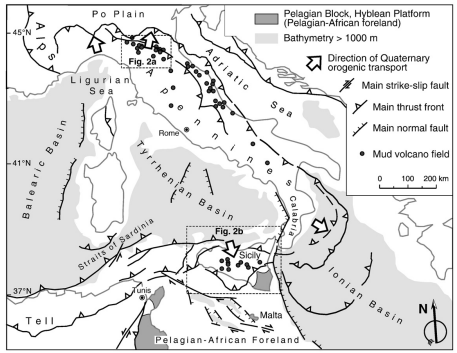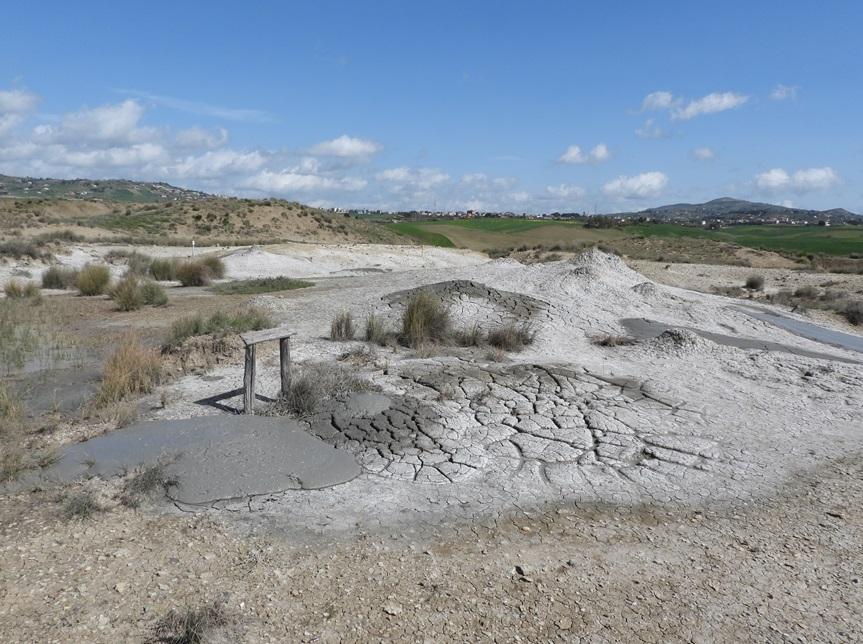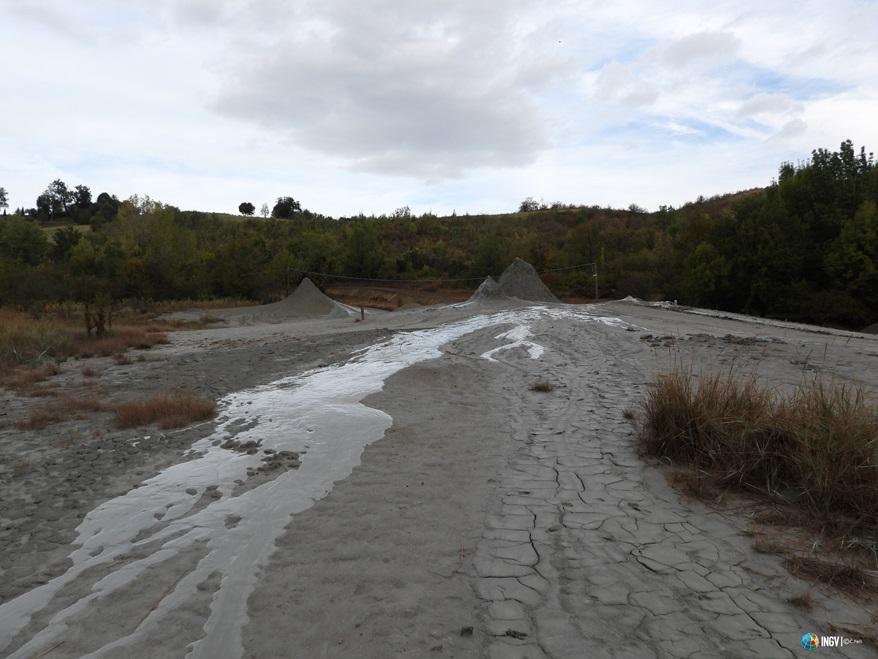Maccalube d’Aragona and Salse di Nirano
In Italy four main geographical zones host mud volcanoes: the northern Apennines (primarily the Emilia-Romagna Region); the central Apennines (Marche and Abruzzo Regions); the southern Apennines (Basilicata, Calabria and Campania Regions) and Sicily. Italian mud volcanoes are generally small and rather flat, and characterized by a continuous and fairly quiet expulsion of gas, water and mud.

Figure 1. Location of the main study areas.
Two main study areas (Figure 1 and 2), that are both Italian Nature Reserve, were selected for this project: Maccalube di Aragona (Sicily) and Salse di Nirano (Northern Apennines).

Figure 2. Structural framework of the Apennines, Italy, and location of the study areas of mud volcanism (after Bonini, 2009).
Maccalube di Aragona
The "Macalube di Aragona" area is located in Central Sicily (Italy) and is the biggest mud volcanism site of the region.
The site is located within a thick accretionary wedge (up to 6 km), developing in front of the Apennine–Maghrebian thrust belt. Mud volcanism originates in the clastic sediments deposited in a system of thrust-top basins that were progressively shortened and displaced during the late Miocene to Pleistocene. Thrust-related deformation near the frontal part of this belt is still active and the shortening is generated by the NNW–SSE oriented Nubia–Eurasia convergence (Bonini, 2009).

Figure 3. Maccalube d’Aragona mud volcanoes (Sicily, Italy). This picture was taken by the PROMUD project people (WP5).
The emission area covers an area of about 1.4 km2 (Figure 3), where mud volcanoes are characterized by heights ranging from a few centimeters to half a meter. Two main pools (about 3 m in diameter) with water and gurgling gasses are also present. In this area episodic eruptions, even with strong blasts and burning of the released gasses, occur without any periodicity (Cangemi and Madonia, 2014). Methane is the dominant gas.
The site is a Nature Reserve managed by the NGO “Legambiente”.
Salse di Nirano
The Nirano Salse are located in the northern Apennine foothills near Fiorano Modenese.
They sit upon an anticline structure with a NW–SE axis associated with the Pede-Apennines thrust (Bonini, 2008) and are associated with the expulsion of fluids generated in the underlying clastic foredeep deposits. The Pede–Apennine front of the Northern Apennines is marked by active thrust deformation mostly associated with the SSW-dipping Pede–Apennine thrust, thus the mud volcanoes are closely linked to the active tectonic compression (Bonini, 2009).
The mud volcanoes belt is currently active and formed by four main vents composed of a number of individual active cones (Figure 4). These cones are up to 3 m high, and emit mud breccias and mud flows. Methane is the dominant gas.

Figure 4. Salse di Nirano mud volcanoes (northern Apennine, Italy). This picture was taken by the PROMUD project people (WP5).
The site, known since Roman Time, is one of the most beautiful and spectacular mud volcanoes areas of Italy. It is a nature reserve managed by Comune di Fiorano Modenese and Ente Parchi dell’Emilia Centrale of the Emilia Romagna Region.
Other sites
We are also interested in studying the Salinelle di Paternò MV and Santa Barbara MV in Sicily, as well as some MVs belonging to the “Mud Route” in the northern Apennines.
Sicily MVs
As for the Maccalube d’Aragona site, the other MVs of Sicily occur over the accretionary wedge at front of the Apennine–Maghrebian fold-and-trust belt, progressively migrating southward over the Pelagian–African foreland. The clastic sediments deposited in the Caltanissetta Basin, a system of amalgamated thrust-top basins, host the mud volcanoes. The thrust-top basins were progressively shortened and displaced during the late Miocene to Pleistocene and thrust-related deformation near the frontal part of the belt is still active (Bonini, 2009).
Salinelle di Paternò
The Paternò site lies at the contact between the eastern margin of the Sicilian foredeep and the volcanic edifice of Mt. Etna. The activity is strongly influenced by seismic events and changes of volcanic degassing from Mt. Etna. (Boni, 2009). Carbon dioxide provided by the igneous activity of Etna dominates among the emitted gasses (Etiope et al., 2002).
Santa Barbara
Santa Barbara mud volcano is located close to the city of Caltanissetta at Santa Barbara Village.
The site occupies an area of about 12 Km2 where cone-shaped structures tens of centimeters high are present. Two paroxysmal eruptions recently occurred at this mud volcano, on 11 August 2008 and an associated minor event in August 2009. Both the events caused severe damage to civil infrastructures located within a range of about 2 km from the eruptive vent (Madonia et al., 2011; Cangemi and Madonia, 2014).
Northern Apennine MVs
As for the Salse di Nirano, the other mud volcanoes that punctuate the Pede–Apennine front of the Northern Apennines (‘Mud Route’) are associated with the expulsion of fluids generated in the underlying clastic foredeep deposits, and are linked to the active tectonic compression acting in the area. Methane is always the dominant gas. (Bonini, 2009).


